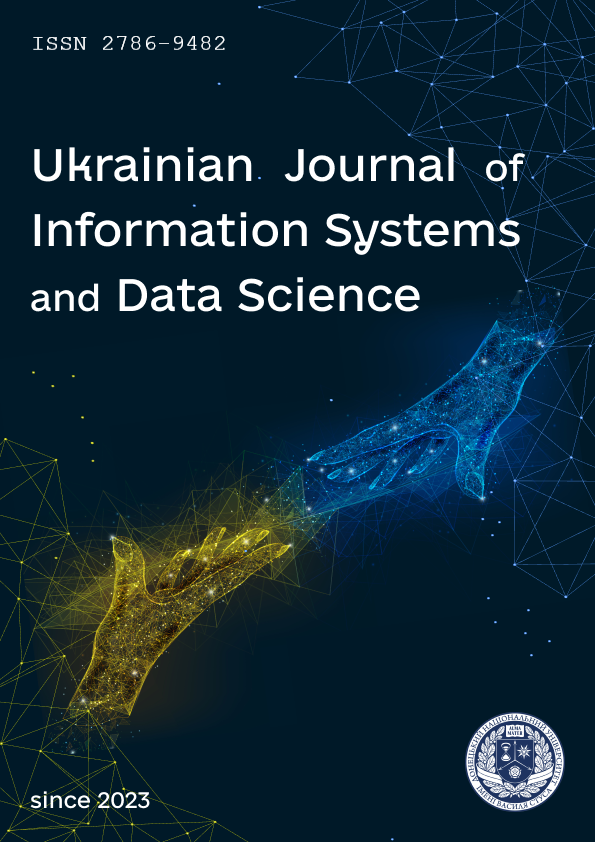Application of a fuzzy cognitive map for the simulation of the Russia-Ukraine war
DOI:
https://doi.org/10.31558/2786-9482.2023.1.1Keywords:
Russia-Ukraine war, fuzzy cognitive map, scenario modelling, nuclear threat, ranking of influencing factors, pair effects.Abstract
The Russia-Ukraine war is an actual object of modelling by techniques of operations research and system analysis. The most important aspect is modelling the threat of nuclear weapon attack, which is related to the potential ability of the Russian Federation. The Russia-Ukraine war is considered as a dynamic system, whose variables are factors affecting the losses of the Russian army and the threat of nuclear weapons attack. A fuzzy cognitive map is used for modelling. A fuzzy cognitive map is a directed graph, the vertices of which are variables of the model, and the weights of the arcs are the forces of positive and negative effects of variables on each other. The factors affecting the losses of the Russian army and the threat of a nuclear strike are selected as follows: resistance of the Ukrainian army, support of Ukraine with weapons, economic sanctions against Russia, opposition of the Russian government and its instinct for self-preservation. The forces of influence of factors on each other and on the possibility of using nuclear weapons are evaluated by experts with the help of fuzzy terms to which numerical quantities correspond. A genetic algorithm is used for tuning the fuzzy cognitive map. The genetic algorithm finds out the forces of influence of factors that minimize the distance between the simulation results and expert assessments. The obtained fuzzy cognitive map is used for scenario modelling of the Russia-Ukraine war according to the what-if analysis and for ranking the factors according to the degree of their influence on the level of nuclear threat. This work shows that fuzzy cognitive maps are an analogue of differential equations, which are traditionally used to model the loss dynamics in military conflicts. The fuzzy cognitive map advantage lies in the possibility of using expert information to account for interrelated factors affecting the loss dynamics and the nuclear threat level. A promising direction for further research is the extension of the proposed model for proceeding with the detailed classification of factors influencing the progress of the Russia-Ukraine war.
References
Зайченко, А. П. (2001). Дослідження операцій: підручник. Київ, ВІПОЛ, 688 с.
Novikov, D. A. (2013). Hierarchical models of warfare. Autom Remote Control, 74(10), 1733–1752. DOI: 10.1134/S0005117913100135.
Shumov, V. V. (2020). Mathematical models of combat and military operations. Computer Research and Modeling, 12(4): 907–920. DOI: 10.20537/2076-7633-2020-12-4-907-920.
McLucas, A. C., & Elsawah, S. (2019). System dynamics modeling to inform defense strategic decision-making. In Encyclopedia of Complexity and Systems Science (pp. 1–33). Springer Berlin Heidelberg. DOI: 10.1007/978-3-642-27737-5_657-1.
Lanchester, F. W. (1916). Aircraft in warfare: The dawn of the fourth arm. Constable limited, 243 p.
Barlow, R. E., Proschan, F. (1975). Statistical theory of reliability and life testing: probability models. Florida State Univ Tallahassee, 327 p. DOI: 10.2307/1402970.
Barnard, A. (2012). Ten things you should know about HALT & HASS. In Proceedings – Annual Reliability and Maintainability Symposium. DOI: 10.1109/rams.2012.6175457.
Kosko, B. (1986). Fuzzy cognitive maps. International Journal of Man-Machine Studies, 24(1), 65–75. DOI: 10.1016/s0020-7373(86)80040-2.
Wierman, M. J., Dobransky, M. K. (1992). A review of: “Neural networks and fuzzy systems:” A dynamic systems approach to machine intelligence. B. Kosko, P. Hall, E. Cliffs (eds.). New Jersey, 1991. XXVII + 449 pages. International Journal of General Systems, 20(4), 398–402. DOI: 10.1080/03081079208945045.
Stylios, C. D., & Groumpos, P. P. (2004). Modeling complex systems using fuzzy cognitive maps. IEEE Transactions on Systems, Man, and Cybernetics – Part A: Systems and Humans, 34(1), 155–162. DOI: 10.1109/tsmca.2003.818878.
Fuzzy cognitive maps for applied sciences and engineering (2014). Intelligent Systems Reference Library. E. I. Papageorgiou (ed.). Springer Berlin Heidelberg. DOI: 10.1007/978-3-642-39739-4.
Mazzuto, G., Ciarapica, F. E., Stylios, C., & Georgopoulos, V. C. (2018). Fuzzy cognitive maps designing through large dataset and experts’ knowledge balancing. 2018 IEEE International Conference on Fuzzy Systems (FUZZ-IEEE). DOI: 10.1109/fuzz-ieee.2018.8491657.
Zadeh, L. A. (1975). The concept of a linguistic variable and its application to approximate reasoning-I. Information Sciences, 8(3), 199–249. DOI: 10.1016/0020-0255(75)90036-5.
Nevison, C. H., & Roberts, F. S. (1977). Discrete mathematical models with applications to social, biological, and environmental problems. The American Mathematical Monthly, 84(10), 834. DOI: 10.2307/2322080.
Вольтерра, В. (1976). Математическая теория борьбы за существование. Москва, Наука, 288 с.
Dickerson, J. A., & Kosko, B. (1994). Virtual worlds as fuzzy cognitive maps. Presence: Teleoperators and Virtual Environments, 3(2), 173–189.
De Larminat, P. (Ed.). (2010). Analysis and Control of Linear Systems. Wiley-ISTE. DOI: 10.1002/9780470612521.
Rothstein, A. P. (2019). Risk analysis: fuzzy cognitive maps vs fault trees. Journal of Computer and Systems Sciences International, 58(2), 200–211. DOI: 10.1134/s1064230719020163.
Rotshtein, A., Katielnikov, D., & Kashkanov, A. (2019). A fuzzy cognitive approach to ranking of factors affecting the reliability of man–machine systems. Cybernetics and Systems Analysis, 55(6), 958–966. DOI: 10.1007/s10559-019-00206-8.
Rotshtein, A. P., & Katielnikov, D. I. (2021). Fuzzy cognitive map vs regression. Cybernetics and Systems Analysis, 57(4), 605–616. DOI: 10.1007/s10559-021-00385-3.
Rotshtein, A., Katelnikov, D., Pustylnik, L., & Polin, B. A. (2022). Reliability analysis of man-machine systems using fuzzy cognitive mapping with genetic tuning. Risk Analysis, 43(5), 958–978. Portico. DOI: 10.1111/risa.13959.
Axelrod, R. (Ed.). (2015). Structure of decision: the cognitive maps of political elites. Princeton University Press, 405 p. DOI: 10.1515/9781400871957.
Глушков, В. М. (1974). Введение в АСУ. Киев, Техника, 320 с.
Бутенин, Н. В., Неймарк, Ю. И., & Фуфаев, Н. Л. (1982). Введение в теорию нелинейных колебаний. Москва, Наука, 384 с.
Gen, M., & Cheng, R. (1996). Genetic algorithms and engineering design. John Wiley & Sons, 411 p. DOI: 10.1002/9780470172254.

